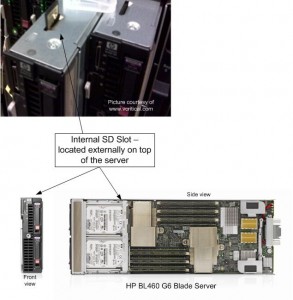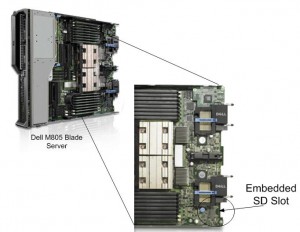Earlier this month Dell EMC unveiled their newest solution of products that combines all of their core products into one system known as PowerOne. This new system will be fully-engineered and highly-automated with autonomous operations and flexible consumption options and is being positioned as “Autonomous Infrastructure” – but don’t call it AI. If you haven’t heard of Autonomous Infrastructure before, it’s because it’s a new category for products that are beyond Converged Infrastructure. The Dell EMC PowerOne combines PowerEdge MX blade servers with PowerMax storage and connects it via Dell EMC Networking while protecting it with Dell EMC Data Protection. I’ll go more into the components at the end of this post, but first I want to focus on what makes PowerOne unique – the automation. Continue reading
Tag Archives: ESXi
Why Blade Servers Could Be the Data Center of the Future
One of my tasks as Chief Technology Architect at Dell is to talk with customers about future technologies. When I reflect on my past vision of where the blade server is heading (“The Blade Server of the Future“) I’m surprised at how close we are to that vision becoming a reality. Based upon where we are heading, the blade server format could be the perfect model for the future datacenter, so let me explain why. Continue reading
What Workloads Are Running on Your Blade Servers?
Higher CPU core counts and faster memory speeds are expanding the use case for blade servers. In years past, a majority of users would say they use blade servers for a dense platform for virtualization. Today, I think there are more workloads than virtualization running on blade servers, but I need your help to decide if my speculation is true. Continue reading
(UPDATED) Blade Servers with SD Slots for Virtualization
(updated 1/13/2010 – see bottom of blog for updates)
Eric Gray at www.vcritical.com blogged today about the benefits of using a flash based device, like an SD card, for loading VMware ESXi, so I thought I would take a few minutes to touch on the topic.
As Eric mentions, probably the biggest benefit of using VMware ESXi on an embedded device is that you don’t need local drives, which lowers the power and cooling of your blade server. While he mentions HP in his blog, both HP and Dell offer SD slots in their blade servers – so let’s take a look:
HP
HP curre ntly offers these SD slots in their BL460 G6 and BL490 G6 blade servers. As you can see from the picture on the left (thanks again to Eric at vCritical.com) HP allows for you to access the SD slot from the top of the blade server. This makes it fairly convenient to access, although once the image is installed on the SD card, it’s probably not ever coming out. HP’s QuickSpecs for the BL460 G6 state offer up an “HP 4GB SD Flash Media” that has a current list price of $70, however I have been unable to find any documentation that says you MUST use this SD card, so if you want to try and use it with your own personal SD card first, good luck. It is important to note that HP does not currently offer VMware ESXi, or any other virtualization vendor’s software, pre-installed on an SD card, unlike Dell.
ntly offers these SD slots in their BL460 G6 and BL490 G6 blade servers. As you can see from the picture on the left (thanks again to Eric at vCritical.com) HP allows for you to access the SD slot from the top of the blade server. This makes it fairly convenient to access, although once the image is installed on the SD card, it’s probably not ever coming out. HP’s QuickSpecs for the BL460 G6 state offer up an “HP 4GB SD Flash Media” that has a current list price of $70, however I have been unable to find any documentation that says you MUST use this SD card, so if you want to try and use it with your own personal SD card first, good luck. It is important to note that HP does not currently offer VMware ESXi, or any other virtualization vendor’s software, pre-installed on an SD card, unlike Dell.
Dell
Dell has been offering SD slots on select servers for quite a while. In fact, I can remember seeing it at VMworld 2008. Everyone else was showing “embedded hypervisors” on USB keys while Dell was using an SD card. I don’t know that I have a personal preference of USB vs SD, but the point is that Dell was ahead of the game on this one.
Dell currently only offers their SD slot on their M805 and M905 blade servers. These are full-height servers, which could be considered good candidates for a virtualization server due to its redundant connectivity, high memory offering and high I/O (but that’s for another blog post. )
)
Dell chose to place the SD slots on the bottom rear of their blade servers. I’m not sure I agree with the placement, because if you needed to access the card, for whatever reason, you have to pull the server completely out of the chassis to service. It’s a small thing, but it adds time and complexity to the serviceability of the server.
An advantage that Dell has over HP is they offer to have VMware ESXi 4 PRE-LOADED on the SD key upon delivery. Per the Dell website, an SD card with ESXi 4 (basic, not Standard or Enterprise) is available for $99. It’s listed as “VMware ESXi v4.0 with VI4, 4CPU, Embedded, Trial, No Subsc, SD,NoMedia“. Yes, it’s considered a “trial” and it’s the basic version with no bells or whistles, however it is pre-loaded which equals time savings. There are additional options to upgrade the ESXi to either Standard or Enterprise as well (for additional cost, of course.)
It is important to note that this discussion was only about SD slots. All of the blade server vendors, including IBM, have incorporated USB slots internally to their blade servers, so whereas a specific server may not have an SD slot, there is still the ability to load the hypervisor onto an USB key (where supported.)
1/13/2010 UPDATE –SD slots are also available on the BL 280G6 and BL 685 G6.
There is also an HP Advisory discouraging use of an internal USB key for embedded virtualization. Check it out at:
IBM BladeCenter HS22 Delivers Best SPECweb2005 Score Ever Achieved by a Blade Server
 According to IBM’s System x and BladeCenter x86 Server Blog, the IBM BladeCenter HS22 server has posted the best SPECweb2005 score ever from a blade server. With a SPECweb2005 supermetric score of 75,155, IBM has reached a benchmark seen by no other blade yet to-date. The SPECweb2005 benchmark is designed to be a neutral, equal benchmark for evaluting the peformance of web servers. According to the IBM blog, the score is derived from three different workloads measured:
According to IBM’s System x and BladeCenter x86 Server Blog, the IBM BladeCenter HS22 server has posted the best SPECweb2005 score ever from a blade server. With a SPECweb2005 supermetric score of 75,155, IBM has reached a benchmark seen by no other blade yet to-date. The SPECweb2005 benchmark is designed to be a neutral, equal benchmark for evaluting the peformance of web servers. According to the IBM blog, the score is derived from three different workloads measured:
- SPECweb2005_Banking – 109,200 simultaneous sessions
- SPECweb2005_Ecommerce – 134,472 simultaneous sessions
- SPECweb2005_Support – 64,064 simultaneous sessions
The HS22 achieved these results using two Quad-Core Intel Xeon Processor X5570 (2.93GHz with 256KB L2 cache per core and 8MB L3 cache per processor—2 processors/8 cores/8 threads). The HS22 was also configured with 96GB of memory, the Red Hat Enterprise Linux® 5.4 operating system, IBM J9 Java® Virtual Machine, 64-bit Accoria Rock Web Server 1.4.9 (x86_64) HTTPS software, and Accoria Rock JSP/Servlet Container 1.3.2 (x86_64).
It’s important to note that these results have not yet been “approved” by SPEC, the group who posts the results, but as soon as they are, they’ll be published at at http://www.spec.org/osg/web2005
The IBM HS22 is IBM’s most popular blade server with the following specs:
- up to 2 x Intel 5500 Processors
- 12 memory slots for a current maximum of 96Gb of RAM
- 2 hot swap hard drive slots capable of running RAID 1 (SAS or SATA)
- 2 PCI Express connectors for I/O expansion cards (NICs, Fibre HBAs, 10Gb Ethernet, CNA, etc)
- Internal USB slot for running VMware ESXi
- Remote management
- Redundant connectivity
